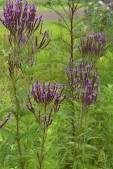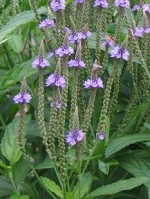 Blue vervain, also known as marsh vervain, is a clump forming herbaceous perennial native to most of the United States where it grows in moist soils such as wet meadows, river bottoms, marshes, and ditches. It is a member of the verbena family, Verbenaceae, that also includes teak and lantana. The plant is erect, may branch in the upper half, and forms colonies by means of slow growing rhizomes and self-seeding. The stems are red or green, four angled, and bear narrow leaves six inches long and one inch across. Each leaf is conspicuously veined and has coarsely toothed margins. The small purple flowers are produced atop terminal stems in densely packed inflorescenes that look like candelabra and open a few at a time from bottom to top over a long bloom time. The flowers attract many different insects including bees and butterflies, and the seeds that follow attract songbirds. Blue vervain is an excellent choice for the wettest and middle part of a rain garden but also does well in drier areas and is drought tolerant once established. Plants may be short lived. The generic name, Verbena, is the Latin word meaning leafy branch or twig and refers to the leaves and twigs of some plants used in sacred ceremonies. The specific epithet, hastata, is the Latin word meaning spear-bearing and refers to the presence of the spear-shaped leaves.
Blue vervain, also known as marsh vervain, is a clump forming herbaceous perennial native to most of the United States where it grows in moist soils such as wet meadows, river bottoms, marshes, and ditches. It is a member of the verbena family, Verbenaceae, that also includes teak and lantana. The plant is erect, may branch in the upper half, and forms colonies by means of slow growing rhizomes and self-seeding. The stems are red or green, four angled, and bear narrow leaves six inches long and one inch across. Each leaf is conspicuously veined and has coarsely toothed margins. The small purple flowers are produced atop terminal stems in densely packed inflorescenes that look like candelabra and open a few at a time from bottom to top over a long bloom time. The flowers attract many different insects including bees and butterflies, and the seeds that follow attract songbirds. Blue vervain is an excellent choice for the wettest and middle part of a rain garden but also does well in drier areas and is drought tolerant once established. Plants may be short lived. The generic name, Verbena, is the Latin word meaning leafy branch or twig and refers to the leaves and twigs of some plants used in sacred ceremonies. The specific epithet, hastata, is the Latin word meaning spear-bearing and refers to the presence of the spear-shaped leaves.
Type: Herbaceous perennial
 Bloom: Small purple flowers are produced on densely packed candelabra-like inflorescences over a long bloom period is summer
Bloom: Small purple flowers are produced on densely packed candelabra-like inflorescences over a long bloom period is summer
Size: 2-6′ H x 1-2.5′ W
Light: Full sun to part shade
Soil: Fertile, wet to moist
Care: Low maintenance
Hardiness: Zones 3-8
Pests and Diseases: None of significance
Propagation: Seed, division
Companion Plants: Bonset (Eupatorium perfoliatum), bottle gentian (Gentiana andrewsii), cardinal flower (Lobelia cardinalis), swamp milkweed (Asclepias incarnate).
